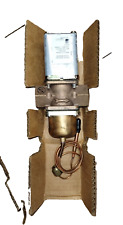
Some 34 million years ago, almost 90 percent of the tiny, shell-bearing sea creatures living along the U.S. Gulf Coast were wiped out and replaced by completely new species of shellfish or mollusks. The same pattern was occurring worldwide, marking the largest global mass extinction since the dinosaurs disappeared. Until now, the cause behind the mass extinction event was a mystery.
Using a new technique that is revolutionizing the way scientists study ancient climate and temperature change, researchers at the University of Michigan and Syracuse University showed that colder winters along the Gulf Coast resulted in the mass extinction at what is known in geological time as the Eocene/Oligocene boundary. Their research is being published in the Oct. 19 issue of Nature.
Their findings are based on an analysis of the chemical composition of fossilized “ear stones,” called otoliths, from a group of fish that survived the mass extinction event. The technique enabled the researchers to determine the temperature of the water during winters and summers, which had not been done before.
“We found that while the summer temperatures remained the same, winter temperatures dropped 4 degrees Celsius,” says Linda C. Ivany, a visiting assistant professor of earth sciences at Syracuse University. “Paleontologists had always suspected that temperature changes had something to do with the extinction, but we couldn’t prove it. Mean annual temperature records for the Gulf Coast that exist for that time period don’t show any change. But they don’t tell you about seasonal variations in temperature.”
Ivany collaborated on the project with Kyger C. Lohmann, U-M professor of geological sciences, and William Patterson, assistant professor of earth sciences at SU.
Lohmann developed a method to collect tiny microsamples of calcium carbonate that could then be chemically analyzed for their stable isotopic composition. Patterson, working with Lohmann, refined the technique and applied it to fossilized otoliths, which are made of calcium carbonate, to determine seasonal climate conditions during a fish’s lifetime. Because the chemical composition of otoliths changes with the temperature of the water in which the fish live, researchers can use the ratio of the stable isotopes of oxygen atoms (oxygen-16 and oxygen-18) found in the calcium carbonate to determine water temperature.
New material forms on the otolith in a series of growth rings much like those found in trees. When the water is cool, the material accumulates relatively more of the heavier oxygen-18 isotope. By analyzing samples of calcium carbonate taken from individual otolith rings, the researchers can, among other things, recover seasonal temperature records for periods of time where none now exist.
It was Ivany’s idea to use this technique to study seasonal variations across the Eocene/Oligocene boundary during which the extinctions occurred. “While scientists often develop methods of resolving Earth history at time scales of days to weeks or months, it takes the insight of researchers like Dr. Ivany to apply existing analytical techniques to questions that address global scale problems,” says Lohmann.
In fact, “this is the first time anyone has looked at seasonality as a variable for an extinction event across a geological time boundary,” Patterson adds. “We proved that winter temperatures caused the extinction. Existing records weren’t able to resolve the change because the records are based on summertime growth. The fish survived the drop in winter temperatures and left a permanent record, while the mollusks didn’t make it to the other side of the boundary.”
Ivany plans to continue her work on Eocene and Oligocene climate and how it relates to extinction events. She will extend the study, applying the same techniques on both otoliths and mollusk shells, to determine seasonal variations in temperature in the North Sea with colleagues from Belgium and on Seymour Island in Antarctica with Lohmann and other colleagues in an effort to understand how climate change affected evolution and extinction during that time interval. She and Patterson will also continue their work on Gulf Coast fossils in an effort to reconstruct the ecology of ancient species.


















Comments are closed.